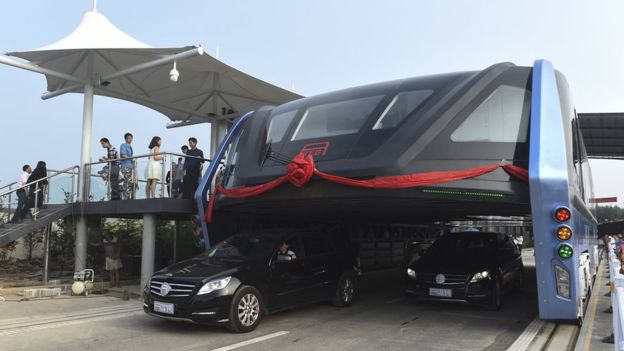Not So Fast: Here’s Why That Chinese Elevated Bus May Not Be Quite What It Seems
The TEB is the latest iteration of a concept that’s been “floating” for decades, but it has some big problems
/https://tf-cmsv2-smithsonianmag-media.s3.amazonaws.com/filer/e6/89/e689f5d6-9bc0-46c9-a090-b87f46277dea/20160804025333938.jpg)
A Chinese company recently unveiled its prototype for a bus that it says could help revolutionize public transit and reduce traffic by gliding over the other cars on the road. With its futuristic, highway-straddling design and potential for bringing an innovative vehicle to China’s roads, the Transit Elevated Bus (TEB) swiftly took the internet by storm. However, while the TEB is an exciting concept, critics say the “elevated bus” may not be quite what it seems.
For starters, calling the TEB a bus is misleading, Sophie Weiner writes for Popular Mechanics. While it may be designed for China’s highways, it still runs on rails, making it more of a commuter train or a giant trolley. Semantics aside, the TEB’s design has some serious flaws when it comes to taking to the road. In China, road vehicles are allowed to be a maximum of around 13 to 14 feet tall, depending on the area. However, the prototype unveiled last week was only tall enough to allow cars less than seven feet tall pass underneath, meaning large vans and trucks could be stuck behind it, Aarian Marshall points out at WIRED.
The test itself raised questions about whether the company was blowing its product out of proportion. Though it was touted as a road test, the TEB was actually tested on a straight, unobstructed track less than 1,000 feet long. That is nothing like real-life road conditions on a congested highway would be like, Sarah Lin reports for Shanghaiist. As a result, it’s unclear how the TEB would handle commonplace things like turning a corner, stopping at traffic lights or dealing with dangerous drivers. Furthermore, while the company originally billed the demonstration as a road test, local officials later said they were unaware of it, Lin writes. Later, the TEB’s manufacturer walked the claim back, saying it was part of their “internal testing.”

Meanwhile, two Chinese state-run media outlets are alleging that the entire project is little more than a scam to hoodwink investors out of their money. Both the Global Times and Sina say that the TEB is being funded as a peer-to-peer investment project, a controversial form of financing in China that matches investors with borrowers while promising high rates of return. Recently, Chinese authorities have begun cracking down on these financial brokers, with one infamous financier cheating hundreds of thousands of investors out of $7.54 billion, Lin reports.
This isn't the first time the idea of an elevated bus skimming above the road and bypassing the traffic underneath has surfaced. Indeed, the idea has been bopping around for decades. The “Landliner” was proposed by designers Craig Hodgetts and Lester Walker in a 1969 issue of New York magazine, and was originally imagined as a transit system that spanned from Washington, D.C., to Boston.
Though it was intended as a thought experiment, Hodgetts and Walker proposed a system of turbine-powered elevated machines snapping up commuter-loaded buses as they glided along highways on “friction-free air cushions.” Theoretically, their plan was to use it for connecting a massive future mega-city stretching for hundreds of miles along the east coast.
The Landliner might have been a science fiction-inspired design drawn from the dreams of the Jet Age, but the designers made some interesting points. Because state governments already owned the land beneath the highways and the infrastructure was already in place, Hodgetts and Walker posited that it wouldn’t be as difficult to do as installing new subways or train tracks.
Urban designers have taken this idea up in a way, proposing new and better bus lines instead of expensive subways or commuter rails. While the TEB might not be all its cracked up to be just yet, the road of innovation continues to move, or rather glide, on down the road.